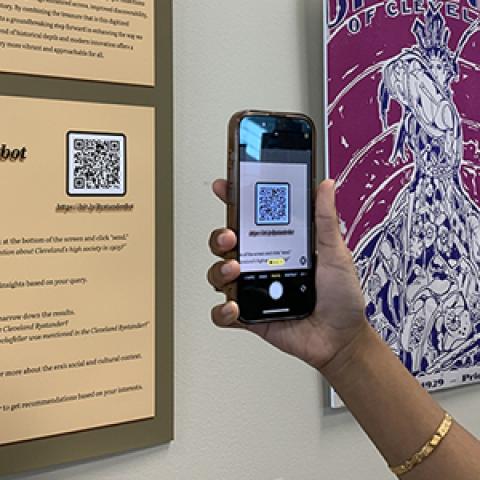The Cleveland Bystander offers a fascinating glimpse into Cleveland’s high society during the late 19th and early 20th centuries and is now accessible online through Digital Case, the university’s platform for curated digital content. Originally published as Cleveland Town Topics and Country Club News before merging into one publication in the late 1920s, the Cleveland Bystander provided a voice for gossip and commentary, a place to learn about what people were wearing, where they were going, who they were with and embraced new technologies such as the automobile, radio and movies.
Digitizing and sharing this collection, including creating the chatbot, took a combined four years to complete. It marked a significant milestone for Kelvin Smith Library, as the collection comprises 88 volumes, occupying 4.3 terabytes of storage space solely for the accessible online versions.
To celebrate this milestone, the library is exhibiting physical copies of the colorful and engaging cover art, providing a visual journey through the publication’s history. Exhibit visitors are guided through the display with a chatbot, accessible with a QR code. The exhibit materials encourage viewers to follow the chatbot link and ask questions like, 'What fashion was popular in Cleveland in the 1920s?"
“This large and valuable source of textual data became accessible at an opportune time, with libraries and cultural heritage institutions looking for ways to integrate AI into their field—a relevant topic at Case Western Reserve University and its libraries,” said Digital Collections Librarian Crissandra George.
Tharun Viswanathan, a second-year student studying Computer & Electrical Engineering who works as a digital collections student assistant, recalls the collaboration with George to develop interactive software that would promote engagement and increase access to the newly accessible collection.
“This served as the foundation for my research on what would be the best way to assimilate all the data in the magazines and present it in a form that many people can view and interact with,” said Viswanathan. “Thus, I came across the idea of creating it into a chatbot.”
The team encountered some challenges incorporating the historical depth of the magazines with modern innovation.
“The goal was to create a product that could answer questions based on the content of the magazines in a way that the general public could easily understand,” said Viswanathan.
This was Viswanathan's first time creating a chatbot, and it was necessary to research the infrastructure and select the right software that could sustain the volume of data from the magazines. He chose OpenAI’s model, served via Microsoft Azure. The most difficult challenge arose when trying to convert the chatbot into a website. The fundamental chatbot was disrupted during this process, leaving Viswanathan to review hundreds of lines of code to resolve the issue. Despite the difficulty, it encouraged him to think creatively and become a better programmer.
“I used Hololens technology to explore ancient Greece in one of my classes,” said Viswanathan. “That experience inspired me to find a way to connect new technology with old materials, enabling us to understand history from a different perspective.”
The Bystander Chatbot project highlights Kelvin Smith Library’s commitment to innovation, highlighting collections in new ways and supporting student workers with real-world experiences.
“This project has had a positive impact on my career and personal goals,” said Viswanathan. “Working with the chatbot technology has made me a more well-rounded engineer and complements the work I’m studying in my classes.”
Read more details about George and Viswanathan’s experience creating the Bystander Chatbot in ACRL’s LibTech Insights, a content vertical that highlights the impact of educational technology in academic libraries.


